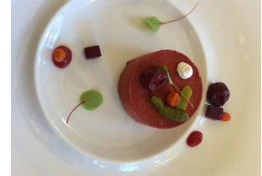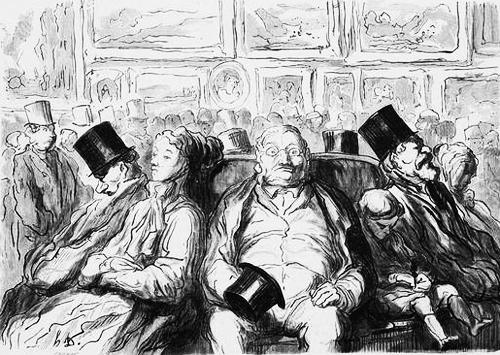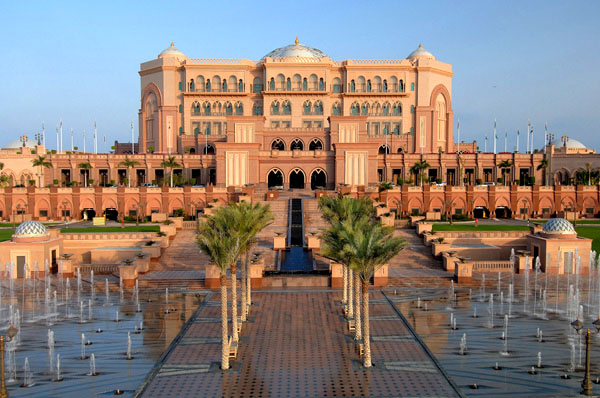Honoré Daumier, Exposition des Beaux-Arts, 1869.
DB here:
Over the last couple of years, I’ve been worried about those critics who must suffer the indignities of film festivals. I became aware of the hazards when I saw this exchange on Indiewire [2]about James Gray’s The Immigrant:
Critic: Do you see this as your most emotional work?
James Gray: I don’t know, I mean I hope so. I know this sounds phony but I don’t start out on a project going, “I’m going to make an emotional work,” you know what I mean? You try to tell the story directly and honestly and with passion…
(A server interrupts to make sure we’re OK and leaves.)
Gray: I love France, I love the French, I’m ready to go home. Three days it took me to get my underwear back from the laundry. Also the worst concierge service in all of human history. I had tickets for all these guests of mine, and they said “Oh, we’ll slip it under your door,” and like seven hours later they lose the…anyway, I’m sorry.
Critic: No, no. Getting a glass of water at this hotel takes half an hour.
Gray: Yeah, it’s like scaling K2.
Mr. Gray, they say [3], is an amusing guy, so perhaps his complaints were wry jokes. I hope not. These slights and discomforts deserve to be recorded. They might seem minor to someone not professionally employed to fly to Cannes, but they’re typical of the hazards critics submit to for our sake. Curious, I looked into the recent adventures of some high-profile writers.
In all, critics bear their indignities with remarkable aplomb. They are unfailingly generous with praise when things are going well. Take the communiqués of Meredith Brody. Her encounters with famous people (luckily for us, she knows everyone) mingle with tales of fashion and delectable dining. As one who misses old Hollywood, I’m pleased that the festival scene has its Hedda Hopper. Here’s a bulletin from Telluride [4]:
With the kind permission of Steve Ujlaki, dean of the Loyola Marymount University School of Film and Television, I was able to join his table for dinner at Rustico at 6, down a lovely plate of veal with mushrooms, and still make Serge Bromberg’s 7:15 “Retour du Flamme.” . . . It took me a while to find Alice Waters’ rented house, tucked away at the top of a steep street, but inside I find great wine, charcuterie, cheese, bread, chocolate, and refugees from the festival’s starriest party, to which I hadn’t been invited. . . .
I told Alexander Payne I was sad that they hadn’t scheduled an additional screening of the 1965 Italia film “I Knew Her Well” that he’d introduced night before last. . . . And maybe he was pulling my leg, but he said something about it being scheduled at some cinematheque in his home state of Nebraska, where he lives part-time. . . . Tom Luddy arrived in a dazzling Russian constructivist cashmere sweater, which his wife, stylist Monique Montgomery, had found at the Alameda Flea Market. He was thrilled that Dave Eggers and Vendela Vida had so enjoyed their first visit to Telluride that they’d become lifers.
And from Bologna’s Cinema Ritrovato [5]:
Walking back from “La Grande Illusion” last night, I run into Haden Guest (of the Harvard Film Archive) and Rani Singh of the Getty Institute, on the way back to their hotel. Days ago I told Haden I wanted to introduce him to Steve Ujlaki, Dean of the Loyola Marymount University School of Film and Television; it turns out they met accidentally on their own, in a fascinating-sounding wine bar, although they didn’t get around to actual introductions. I realized it must be Haden Steve and Jackie were talking about when they said that he was elegantly dressed, “in a pork pie hat and linen jacket.” I confirm this by showing him pictures of them from the amazing dinner we’ve just shared.
I frustrate both Haden and Rani by describing the meal and not being able to tell them the name of the restaurant. That’s something that annoyed the hell out of me when I was regularly writing about restaurants and people would tell me they’d just been to a place I would love and then be unable to tell me its name or address. I can show them a picture of the façade of the place, but it’s hard to read the sign. . . . A last lunch at Bertino: prosciutto e melone, straw and hay with sausage sauce, tagliatelle with ragu. Only a glance at sparkling wine (dare not) and a heavily-laden dessert cart (better not).
The churlish will object that the films screened get little discussion in these flavorsome pieces, but that misses the point. The function of most festival reviewers is to function as a DEW system, or a first filter. They must signal those buzzworthy films that if we’re lucky, we’ll see a few months or years hence. Their task is to predict the winners. (Indeed, their coverage helps create the winners.) Given that the films will be over-discussed in the months to come, why not share with us the more ephemeral joys of the festival atmosphere–the parties, the food and drink, the networking, the celebrity bons mots?
When it comes to evoking la dolce vita of the festival circuit, no one surpasses Mark Adams of Screen Daily/ Screen International. Consider his 2012 description of the annual Arabian Nights party at the Emirates Palace Hotel at the Abu Dhabi Film Festival [6].
The party aims to replicate – as only a five-star hotel can do – the desert experience, and is set up with food-stands a-plenty as well as singing, dancing, a Western-style DJ (very popular), shisha pipes – for those who partake – and even chill-out seats out on the sand with the possibility of a close encounter with a camel.
In fact this party has developed into a must-go-to event for festival regulars, with an elegant and laid-back vibe that is a perfect counterbalance to the excitement of the opening night bash and the champagne excesses of the Möet & Chandon event.
Champagne excesses? Tell us more [7], especially the classy parts.
The nice thing about the Moët & Chandon bash is that it is delivered with a certain class. The champagne was chilled and tasty, the asparagus risotto delicious and the delicate desserts delightful. Plus there were fire-eaters, a dancer sprayed silver and a woman dancing in an oversized birdcage….
But while the Moët party was certainly a classy affair – and with a strict invite list it keeps things modest but classy – it all rather pales when you head back into the Emirates Palace hotel and its cavernous golden corridors, gleaming hallways, splendid domed foyer and sheer sense of confident opulence….
Gold and marble are the key aspects to the hotel. Much has been written about the gold ingot vending machine in the foyer, but love it or loathe it there is no denying the sheer visual impact of the building, which was designed by architect John Elliott, and which opened in 2005.
Forget the 1.3km of white sandy beach, the private marina and the two helipads…the Emirates Palace hotel is all about scale. It is 1km from wing to wing (100 hectares total area); there are 102 elevators (I’ve only used two) and 1002 chandeliers, and some 5kg of pure edible gold is used per year for decoration on desserts.
At a period when people are losing their jobs, not getting jobs, losing their savings, finding themselves unable to save, and generally suffering from a depressed economy and a failing social-services system, it’s entirely appropriate that Adams spare a thought for those less fortunate than his hosts.
Sadly that self same edible gold on some very nice strawberriess at a Swedish reception was the nearest I’ve come to getting my hands on the real thing. . .
He’s quite aware that not every venue can splash out this way. The Transylvania Film Festival gamely makes do [8].
Even the faded and empty Continental Hotel on the edge of the square was being used for a costume exhibition that seemed to fit perfectly into the crumbling main entrance hall of the hotel, with its musty smell and peeling, once-grand ceiling.
And [9] Adams reminds us:
Maybe it’s a sign of the times, but even movies are reflecting the stark fact that expensive hotels are beyond the reach of many, and camping or caravanning are other options. Camping was very much the thing in Cannes opener Moonrise Kingdom. . . .
Still, even if you stay in fine digs, there are those hazards. Without hesitation Adams throws a spotlight on the dangers of being a festival-going critic–plagued by officious doormen, long queues, and chattering cinephiles. Even the weather sometimes fails to cooperate [9].
After stints at the Venice and Toronto film festivals let me tell you, my capacity — let alone enthusiasm — for queuing is pretty much depleted. Yes, getting there nice and early does guarantee you a seat but standing in line is an intrinsically wearying pursuit as you stave off boredom by waving to friends, checking e-mails and becoming more and more annoyed as sly folk cajole or charm their way into the line ahead of you. . . .
At Venice this year, most of the early press screenings (which sometimes mixed in members of the public) were held at the cavernous Darsena cinema. With 1,300 seats available there’s always a good chance you’ll get in, but that doesn’t mean there aren’t a variety of ruses tried by some to force their way into the queue at an earlier point. Some try the old ‘friend holding a place’ routine; others adopt the ‘phone glued to ear and not really aware there was a queue’ policy, while some are just plain rude.
Mind you, it was so hot in Venice that the outdoor queue was rather wearisome, though at least the security folk didn’t snaffle water and liquids of any kind as they did in Cannes this year. Oddly there were three queues set up for the Darsena depending on your badge — from priority daily press through to periodicals — and all were let in at exactly the same time. . . .
Toronto favours long, winding queues that weave back and forth, like being in a bank or an airport baggage drop-off. In the case of screenings at the Bell Lightbox this also involves going up escalators, marshalled by grinning volunteers and festival folk with annoying headsets. But while frustrating they are quite well organised — until you are left outside a film that is late starting due to a digital problem, and have to put up with film folk around you pontificating on every film they have seen.
Fortunately, you can get away from the grind occasionally. Unlike Brody, who sandwiches her gustatory adventures between screenings, Adams favors a vacation [10]. Even during R & R, however, he’s on the job, passing along his musings on cinema.
Time for a well-earned holiday with friends and family down in the bakingly hot Tarn region of southern France. Blessedly it is an area not favoured by hordes of British tourists but — rather sadly — it lacks a plethora of multiplexes to catch up on the latest film fare.
There was not even a local film festival to overlap with my trip, unlike a holiday in Umbria a few years ago, where a tiny and picturesque hilltop town was staging a Mike Leigh retrospective. And no, much as I love Mike, I didn’t hang around to catch his appearance.
While floundering in the pool, tanning in the 37 degree heat, sampling the delightful variety of Gallic wines and sweating on a baking-hot tennis court were all fine distractions, let’s face it, you can’t beat a good movie.
I wrote the foregoing a year ago, but I decided not to post it. I thought that the trend I’d spotted had faded. Film critics seemed to have given up their scintillating travelogues for the humdrum task of discussing movies. But a recent report from Anne Thompson made me decide to revive the old piece. A couple of days ago, Thompson took off [11] for Karlovy Vary.
I flew from LA to Paris en route to the 49th Karlovy Vary International Film Festival (KVIFF) on a 500-seat double-decker Air France A380 that is the largest passenger aircraft in the world. Lufthansa and Emirates Airlines also fly them. It’s the smoothest, quietest flight ride I’ve ever had, you barely noticed the plane taking off.
I walked, “Snowpiercer” style, through the economy steerage, up the curved staircase at the tail and back through business and first class, which features ten full sleepers. The three-year-old jumbo jet had video footage of three live cameras mounted on the nose, belly and tail.
Cool.
So far, so good. But where are the eats?
Later that night I ran into Gibson and his long-time publicist Alan Nierob in the VIP basement lounge of the Grand Hotel Pupp, as the opening night party raged through many rooms above, with lavish spreads with everything from roast beef, aspic and deviled eggs to tongue-melting fresh sword steaks grilled on demand. He [Mel] showed me his latest movie-star tattoo.
On cue, Meredith Brody posts a culinary comment.
ps: two things: I know it would be kinda a busman’s holiday, but did you see any movies on the plane? AND tongue-melting sushi?!
As if in reply, Thompson’s second day report [12] features more tastiness and adds a picture and a comparison of film to–what else?–food.
 [13]I interviewed achievement-award-winner Mel Gibson on video (we’ll post soon) before the official festival dinner at the Grand restaurant. I nibbled at a paté of duck liver and fois gras with cherries and beetroot as I chatted with the city Mayor (who runs a film club) and the Czech Minister of Culture, who is a rare Roman Catholic in a country of post-Communist atheists….
[13]I interviewed achievement-award-winner Mel Gibson on video (we’ll post soon) before the official festival dinner at the Grand restaurant. I nibbled at a paté of duck liver and fois gras with cherries and beetroot as I chatted with the city Mayor (who runs a film club) and the Czech Minister of Culture, who is a rare Roman Catholic in a country of post-Communist atheists….
I’ll report anon on what I do see–of the 200-some films on display are a tempting smorgasbord of the best of the international festivals.
I think I speak for other readers: Festival critics, we know you face moments of despair. But make the sacrifice. Soldier on. Tip us to strong sweepstakes entries. (Thompson on Calvary: “This will make many critics’ ten-best lists.”) And don’t spare us lifestyle details.
Full disclosure: Kristin and I have praised Lillooet Fox‘s waffles at VIFF [14].

